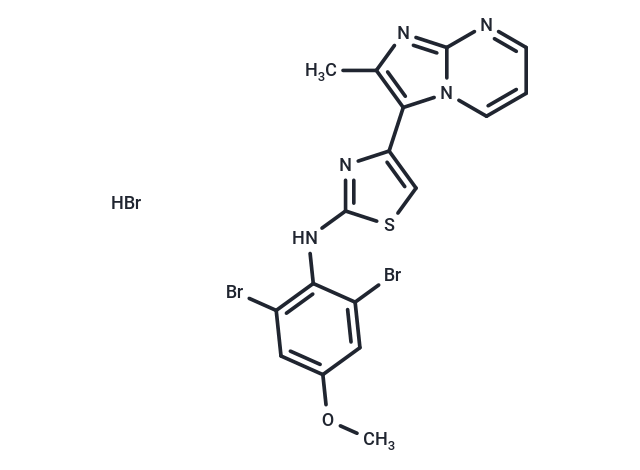Shopping Cart
Remove All Your shopping cart is currently empty
Your shopping cart is currently empty
PTC-209 hydrobromide (PTC-209 HBr) is the hydrobromide salt of PTC-209, which is a potent and selective BMI-1 inhibitor with IC50 of 0.5 μM, and results in irreversible reduction of cancer-initiating cells (CICs).

| Pack Size | Price | USA Warehouse | Global Warehouse | Quantity |
|---|---|---|---|---|
| 1 mg | $31 | - | In Stock | |
| 5 mg | $71 | - | In Stock | |
| 10 mg | $126 | - | In Stock | |
| 25 mg | $279 | - | In Stock | |
| 50 mg | $489 | - | In Stock | |
| 100 mg | $793 | - | In Stock | |
| 200 mg | $1,090 | - | In Stock | |
| 1 mL x 10 mM (in DMSO) | $91 | - | In Stock |
| Description | PTC-209 hydrobromide (PTC-209 HBr) is the hydrobromide salt of PTC-209, which is a potent and selective BMI-1 inhibitor with IC50 of 0.5 μM, and results in irreversible reduction of cancer-initiating cells (CICs). |
| Targets&IC50 | BMI1:0.5 μM |
| In vitro | PTC-209 inhibits both the UTR-mediated reporter expression and endogenous BMI-1 expression in human colorectal HCT116 and human fibrosarcoma HT1080 tumor cells. PTC-209 decreases colorectal tumor cell growth in a BMI-1-dependent way. In addition, PTC-209 impairs colorectal cancer-initiating cells (CICs) through irreversible growth inhibition. [1] |
| In vivo | PTC-209 (60 mg/kg/day, s.c.) effectively inhibits BMI-1 production in tumor tissue, and halts growth of preestablished tumors in mice bearing primary human colon cancer xenograft, human colon cancer cell lines LIM1215 or HCT116 xenografts. PTC-209 also reduces the frequency of functional colorectal CICs in vivo. [1] |
| Kinase Assay | Untranslated region-mediated luciferase reporter expression: HEK293 cells are transfected with a GEMS reporter vector that contains the luciferase open-reading frame flanked by and under post-transcriptional control of the BMI-1 5′ and 3′ UTRs. The resulting stable cells (F8) are treated with PTC-209 or vehicle control overnight, and then luciferase reporter activity is determined using Bright-Glo assays. The assays are run in triplicate for each point, and the percentage of inhibition was calculated against vehicle control. |
| Cell Research | To determine whether pretreatment with the inhibitor affects tumor cell growth, cells are plated with the inhibitor for 4 d in vitro and plated in limiting doses in vitro without adding further inhibitor. Trypan blue exclusion is used to count viable cells. The in vitro sphere-initiating cell frequency is calculated after inhibitor treatment by evaluating the number of wells containing spheres. For the experiments where LDAs are set up following recovery of PTC-209 treated cells, 6-well plates were seeded with 1E6 cells per well and incubated overnight. Cells are subsequently treated for 4 d in triplicate with either DMSO vehicle or PTC-209 (0.01, 0.1, 1 and 10 μM). Drug treatments are washed off and 4 mL fresh suspension medium added to all wells. To assess cell viability following the 4 d treatment window, cells are trypsinized and counted at 0, 24, 72 and 120 h after removal of the drug. Long-lasting effects of the drug treatment on sphere-forming ability are assessed by plating LDAs (50,000, 10,000, 1,000,100, 10 and 1 cell per well) using the cells obtained 120 h after the 4-d drug treatment.(Only for Reference) |
| Synonyms | PTC-209 HBr |
| Molecular Weight | 576.1 |
| Formula | C17H13Br2N5OS·HBr |
| Cas No. | 1217022-63-3 |
| Smiles | Br.COC1=CC(Br)=C(NC2=NC(=CS2)C2=C(C)N=C3N=CC=CN23)C(Br)=C1 |
| Relative Density. | 1.31g/cm3 |
| Storage | store at low temperature | Powder: -20°C for 3 years | In solvent: -80°C for 1 year | Shipping with blue ice/Shipping at ambient temperature. | |||||||||||||||||||||||||||||||||||
| Solubility Information | Ethanol: <1 mg/mL H2O: <1 mg/mL DMSO: 93 mg/mL (161.43 mM), Sonication is recommended. | |||||||||||||||||||||||||||||||||||
| In Vivo Formulation | 10% DMSO+40% PEG300+5% Tween 80+45% Saline: 3.3 mg/mL (5.73 mM), Sonication is recommended. Please add the solvents sequentially, clarifying the solution as much as possible before adding the next one. Dissolve by heating and/or sonication if necessary. Working solution is recommended to be prepared and used immediately. The formulation provided above is for reference purposes only. In vivo formulations may vary and should be modified based on specific experimental conditions. | |||||||||||||||||||||||||||||||||||
Solution Preparation Table | ||||||||||||||||||||||||||||||||||||
DMSO
| ||||||||||||||||||||||||||||||||||||
| Size | Quantity | Unit Price | Amount | Operation |
|---|

Copyright © 2015-2025 TargetMol Chemicals Inc. All Rights Reserved.